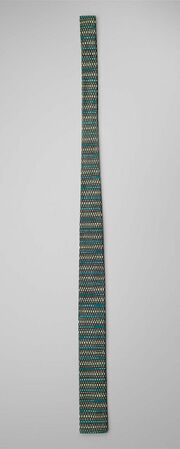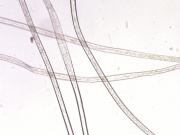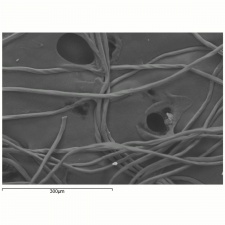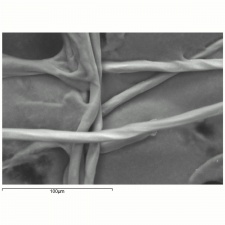Difference between revisions of "Dacron"
m (Text replace - "== Authority ==" to "== Sources Checked for Data in Record ==") |
|||
| (8 intermediate revisions by the same user not shown) | |||
| Line 1: | Line 1: | ||
| − | [[File: | + | [[File:SC198728.jpg|thumb|Man's necktie<br>MFA# 2007.971]] |
== Description == | == Description == | ||
| − | [DuPont] A registered trademark for a [[polyester fiber]] made of [[polyethylene terephthalate]]. In 1951, | + | [DuPont] A registered trademark for a [[polyester fiber]] made of [[polyethylene terephthalate]]. In 1951, Dacron®, along with Terylene in England, became the first commercially marketed polyester fiber. Dacron® is available as yarn, staple, and fiberfill. Polyester is durable, strong, and washes well. It has good resistance to bleaches, ketones, alcohols, soaps, detergents, and dry cleaning agents. Dacron® is also resistant to creasing, abrasion, heat aging, sunlight, and insect attack. It is used for clothing, curtains, belts, fire hoses, and filled products. |
| − | |||
| − | |||
| + | For identification of Dacron fibers, see http://cameo.mfa.org/wiki/Category:FRIL:_Polyester | ||
| + | [[File:55 poly Dacron 200X.jpg|thumb|Dacron at 200x]] | ||
| + | [[File:55 poly Dacron 200X pol.jpg|thumb|Dacron at 200x polarized light]] | ||
== Synonyms and Related Terms == | == Synonyms and Related Terms == | ||
polyester; polyethylene terephthalate; Terylene [ICI]; Fiber V; | polyester; polyethylene terephthalate; Terylene [ICI]; Fiber V; | ||
| − | [[[SliderGallery rightalign|dacron200m.jpg~SEM|dacron500m.jpg~SEM]]] | + | [[[SliderGallery rightalign|DacronTestfabrics.jpg~FTIR|dacron200m.jpg~SEM|dacron500m.jpg~SEM]]] |
| − | == | + | == Risks == |
| + | * Difficult to ignite | ||
| + | * Burns with a shiny, yellow-orange, sooty flame. | ||
| + | * Self-extinguishing | ||
| − | Resistant to cold acids, weak alkalis, bleach and most organic solvents. Degrades in strong alkalis, strong hot acids, cresol. Tenacity = 2.8-5.2 Elongation = 19-30% Moisture regain = 0.4% | + | ==Physical and Chemical Properties== |
| + | |||
| + | * Resistant to cold acids, weak alkalis, bleach and most organic solvents. | ||
| + | * Degrades in strong alkalis, strong hot acids, cresol. | ||
| + | * Tenacity = 2.8-5.2 | ||
| + | * Elongation = 19-30% | ||
| + | * Moisture regain = 0.4% | ||
{| class="wikitable" | {| class="wikitable" | ||
|- | |- | ||
! scope="row"| Melting Point | ! scope="row"| Melting Point | ||
| − | | 250-260 | + | | 250-260 C |
|- | |- | ||
! scope="row"| Density | ! scope="row"| Density | ||
| − | | 1.38 | + | | 1.38 g/ml |
|- | |- | ||
! scope="row"| Refractive Index | ! scope="row"| Refractive Index | ||
| 1.54, 1.72 | | 1.54, 1.72 | ||
|} | |} | ||
| − | |||
| − | |||
| − | |||
| − | |||
| − | |||
| − | |||
| − | |||
| − | |||
== Comparisons == | == Comparisons == | ||
| Line 40: | Line 42: | ||
[[media:download_file_76.pdf|Properties of Synthetic Fibers]] | [[media:download_file_76.pdf|Properties of Synthetic Fibers]] | ||
| + | ==Resources and Citations== | ||
| + | * DuPont: [https://www.dupont.com/fabrics-fibers-and-nonwovens.html Fabrics] | ||
| − | + | * Marjory L. Joseph, ''Introductory Textile Science'', Holt, Rinehart and Winston, Fort Worth, TX, 1986 | |
| − | |||
| − | |||
| − | |||
| − | |||
| − | |||
| − | |||
| − | |||
| − | |||
| − | |||
| − | * | ||
* ''Identification of Textile Materials'', The Textile Institute, Manchester, England, 1985 | * ''Identification of Textile Materials'', The Textile Institute, Manchester, England, 1985 | ||
| − | * | + | * G.S.Brady, ''Materials Handbook'', McGraw-Hill Book Co., New York, 1971 Comment: p. 625 |
| − | * | + | * Richard S. Lewis, ''Hawley's Condensed Chemical Dictionary'', Van Nostrand Reinhold, New York, 10th ed., 1993 |
* ''The Merck Index'', Martha Windholz (ed.), Merck Research Labs, Rahway NJ, 10th edition, 1983 Comment: entry 7730 | * ''The Merck Index'', Martha Windholz (ed.), Merck Research Labs, Rahway NJ, 10th edition, 1983 Comment: entry 7730 | ||
| Line 63: | Line 57: | ||
* Art and Architecture Thesaurus Online, http://www.getty.edu/research/tools/vocabulary/aat/, J. Paul Getty Trust, Los Angeles, 2000 | * Art and Architecture Thesaurus Online, http://www.getty.edu/research/tools/vocabulary/aat/, J. Paul Getty Trust, Los Angeles, 2000 | ||
| − | * | + | * AMOL reCollections Glossary at http://amol.org.au/recollections/7/d/htm |
[[Category:Materials database]] | [[Category:Materials database]] | ||
Latest revision as of 14:56, 14 July 2022
Description
[DuPont] A registered trademark for a Polyester fiber made of Polyethylene terephthalate. In 1951, Dacron®, along with Terylene in England, became the first commercially marketed polyester fiber. Dacron® is available as yarn, staple, and fiberfill. Polyester is durable, strong, and washes well. It has good resistance to bleaches, ketones, alcohols, soaps, detergents, and dry cleaning agents. Dacron® is also resistant to creasing, abrasion, heat aging, sunlight, and insect attack. It is used for clothing, curtains, belts, fire hoses, and filled products.
For identification of Dacron fibers, see http://cameo.mfa.org/wiki/Category:FRIL:_Polyester
Synonyms and Related Terms
polyester; polyethylene terephthalate; Terylene [ICI]; Fiber V;
Risks
- Difficult to ignite
- Burns with a shiny, yellow-orange, sooty flame.
- Self-extinguishing
Physical and Chemical Properties
- Resistant to cold acids, weak alkalis, bleach and most organic solvents.
- Degrades in strong alkalis, strong hot acids, cresol.
- Tenacity = 2.8-5.2
- Elongation = 19-30%
- Moisture regain = 0.4%
| Melting Point | 250-260 C |
|---|---|
| Density | 1.38 g/ml |
| Refractive Index | 1.54, 1.72 |
Comparisons
Properties of Synthetic Fibers
Resources and Citations
- DuPont: Fabrics
- Marjory L. Joseph, Introductory Textile Science, Holt, Rinehart and Winston, Fort Worth, TX, 1986
- Identification of Textile Materials, The Textile Institute, Manchester, England, 1985
- G.S.Brady, Materials Handbook, McGraw-Hill Book Co., New York, 1971 Comment: p. 625
- Richard S. Lewis, Hawley's Condensed Chemical Dictionary, Van Nostrand Reinhold, New York, 10th ed., 1993
- The Merck Index, Martha Windholz (ed.), Merck Research Labs, Rahway NJ, 10th edition, 1983 Comment: entry 7730
- Art and Architecture Thesaurus Online, http://www.getty.edu/research/tools/vocabulary/aat/, J. Paul Getty Trust, Los Angeles, 2000
- AMOL reCollections Glossary at http://amol.org.au/recollections/7/d/htm





